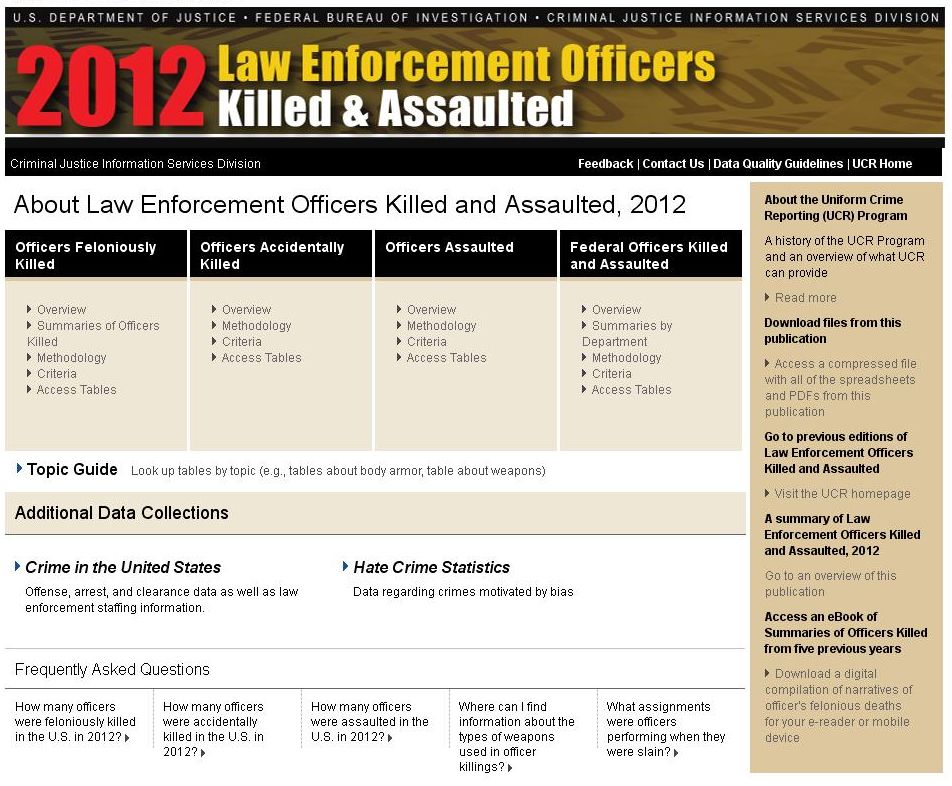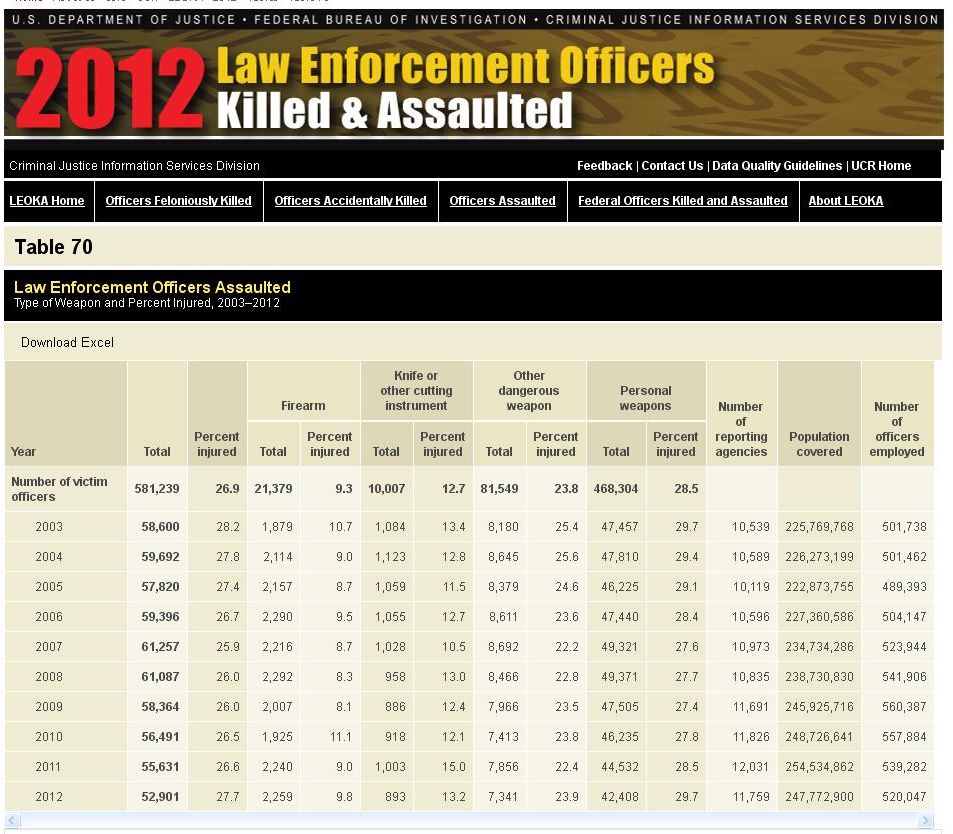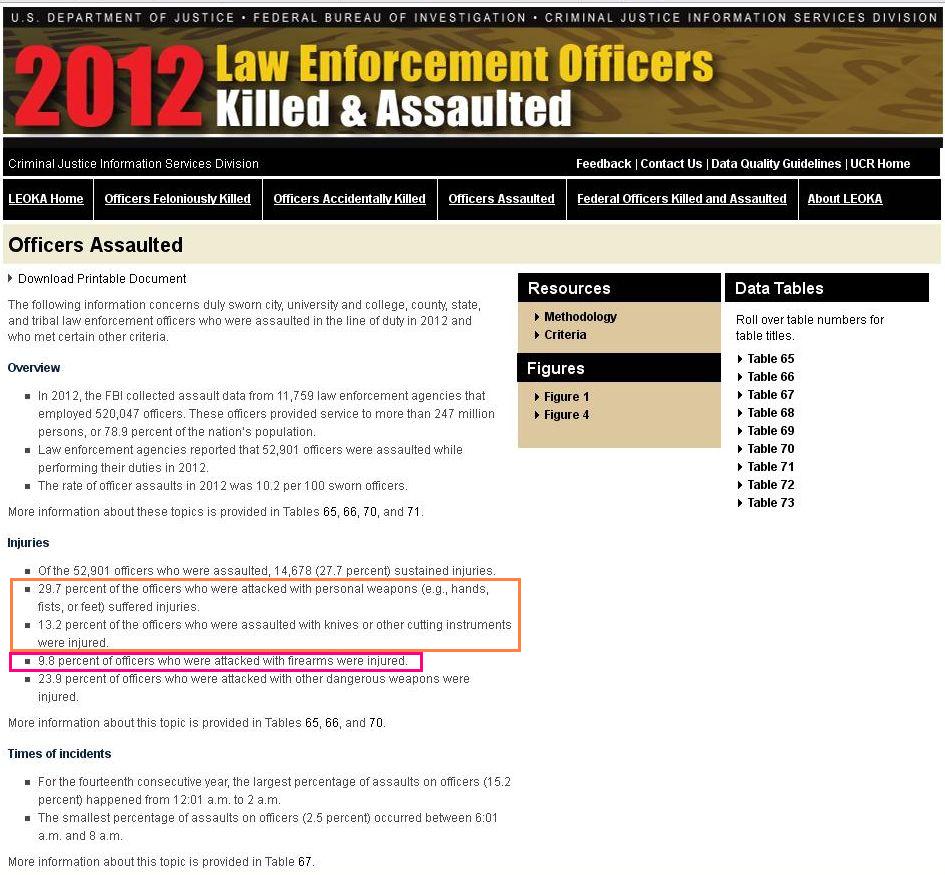
Image from FBI.gov
Well, neither of those statements can be proven true based on the information supplied by “the FBI.” The available facts are actually a lot less conclusive than many people portray them as. Consequently, there is a great deal of unsupportable extrapolation of the facts that do exist.
The data that is being referred to is compiled and published as part of the FBI’s annual Law Enforcement Officers Killed & Assaulted report, which is available to download from the FBI’s website. It is published around the end of October each year for incidents occurring the previous year.
Since LEOKA 2012 has just been released, let’s examine the assertions about them. Unfortunately, the FBI does not gather information about distance of gunfights in routine submissions to the Uniform Crime Reporting (UCR) Program. The only information on distances is gathered as supplemental data in cases where police officers are actually killed. These data are compiled in Table 36 — Distance Between Victim Officer and Offender, 2003–2012, in the current report. However, this table reports only a very small subset (44) of “gunfights” police engaged in. The data that is collected about the total number of police gunfights (2,259) is compiled in Table 70 — Type of Weapon and Percent Injured, 2003–2012. No distances are provided in this table.

Image from FBI.gov
Table 70 does list an interesting piece of information that provides a reality check on the “zero to three feet distance” assertion. Of the 2,259 Assaults with Firearms, only 9.8% resulted in injury. However, 13.2% of the officers who were assaulted with knives or other cutting instruments were injured. Statistically, it seems unlikely that within the same zone of influence, knives would result in a 35% higher casualty rate than firearms.

Image from FBI.gov
- Personal weapons – 28.5%
- Other dangerous weapons – 23.8%
- Knives or other cutting instruments – 12.7%
- Firearms – 9.3%
If most police gunfights took place within three feet, it would seem reasonable to expect that the injury rate would most likely approach 100% rather than 9.3%. Using these data to partially vet the distance of police gunfights would seem to indicate that police gunfights do not take place at near-contact distances. More likely, gunfights actually take place at considerably longer distances, where the popular spray-and-pray point-shooting techniques employed by criminals are rather ineffective.

Image from FBI.gov
Looking at the overview of officers killed in 2012 also provides some interesting information. Forty-four officers were killed with firearms, 32 with handguns. However, only seven officers fired their weapons, and two additional officers attempted to use their weapons. Twenty-four of the officers killed with firearms were within five feet from the offenders. Combining the data of officers who fired their weapons with the data of distance the officers were killed at would seem to indicate that officers tend to be slain in “shootings” rather than “gunfights.”
A more justifiable assertion based on the data in Tables 36 and 70 would be that if a police officer is shot (at) by a criminal at a distance of under five feet, the possibility of death is high. The data gathering and analytical capabilities of the FBI and UCR are probably not necessary to arrive at that conclusion. The only study that actually looked at distances of gunfights in a detailed and methodical way was done for Police Marksman magazine by Richard Fairburn in the 1990s. The average distance reported in that study was 14 yards.
Another frequent claim goes something like, “There’s a commonly held and cited statistic that three out of four times, when officers are killed during shootings, it happens in low light.” That “commonly cited statistic” is a fallacy.

Image from FBI.gov
- Mean 12:44pm
- Mode 11:00am
- Median 1:20pm
Of the 64 incidents reported in the 2011 Summaries, only 36% took place between the hours of 2100 and 0700. Of those, in only one incident would a flashlight have had any relevance whatsoever, and even that incident is questionable. For instance, if an offender uses his car to run an officer down at 12:20am, a flashlight is unlikely to help the situation. This isn’t to say that flashlights aren’t useful. However, when using statistics as the underlying premise for an assertion, they should be researched for veracity, rather than be “commonly cited.”

The purpose of this article is not to say that gunfights and shootings don’t take place at close range but rather that stating “the FBI” says they do is incorrect. Statistics can be useful, but their data collection methods and interpretations must be well understood before the final product becomes useful intelligence. And the actual source for the statistic must be determined and vetted to be real and appropriate. If we’re going to use numbers as a basis for our training and decisions, let’s get them correct.
Data are good to have and lots of work to not compile it but deciphering can be challenging. But, overall the bottom line is random gunfights are hard to talk about as to best practice and all that under that "gunfight" umbrella. We are not operators on a specific task, the private Joe's react to situations that presents itself.
Excellent article. Those myths have been going around for at least 30 years as I can remember.
well done - few take the time to study the statistics.
1. We carry firearms in order to kill people who attack us, protected by the very specific and limited laws of self defense. 2. We want to hit what we shoot and to kill what we hit, and to be completely exonerated in a court of law. 3. We understand that, depending on state, prosecutor, local politics, re-election and pressure, we are always in danger in these courts. 4. We understand that even a charge of manslaughter carries a potential penalty of 10 years. 5. We understand that, beyond a very close distance- say 20 feet- we begin to loose our ability to claim unavoidable danger. 6. We accept that for every 5 feet after 20-25 feet, we increasingly risk our actions being labeled as criminal. 7. We accept that after 40-50 feet, we may no longer be able to win a court case and could end up in prison regardless of the legitimacy of our action. 8. We understand that training and skill are far more important than after-market custom builds and endless debates over caliber and manufacturer. 9. We master the tools available to us, that we can afford, and become experts in as many firearms as possible, exposing ourselves to as much and as varied training as we are able, to be able to respond in all conditions. 10. We learn to shoot, hit, and kill, any target within 50 feet, in any position, with either hand, light or dark, without hesitation or remorse. 11. We pick weapons we can handle, that available to us, and we train rigorously with them as we are able, in order to perform within the bounds of self-defense. 12. We do actual research to confirm the actual performance of the rounds we have chosen, and know exactly how they will perform with the firearms WE personally carry, within the physical boundaries of self-defense.
The pistol/revolver is the weapon of last resort (military). But in the civilian world, the pistol is the first choice. We all know that civilians are the wild-card in any community task force, where discipline is non-existent. IFF is a measure of shoot first, without regard to friendlies. I would rather see identification transponders issues to para-military civilian militias, than shooting wildly in all directions. Assassinations are becoming more common, which brings engagements down to Zero. If we quarantine the larger cities, anarchy will take care of itself. Here in Appalachia Ohio, DNR has earned us about ambush possibilities. Instead of a gun, some good camo.
Garbage article. Look at actual, documented gunfights, like the 1986 Miami FBI shootout, or any actual bank robbery or convienent store holdup. Pull up liquor store robbery videos on Youtube. <10 yards, almost without fail. 7 yards has been the average for longer than the author has been alive, and it still is.
Great article. Is the Police Marksman article available online? The 14-yard assertion seems to be contradicted by Fairburn's article here, where he states 20 feet as the average: https://www.policeone.com/police-trainers/articles/7627482-Cops-Survival-Can-10-feet-make-the-difference/.
Shame, I came here for real stats and not cherrypicking..
All of the above has no meaning to "civilians". The average civilian gun fight will take place at 3 to 5 yards.Lets look at the reason. Most civilians will be in a gun fight with a robber or burglar. Very few robbers walk up to their victim gun in hand. And most residence's hallways are 5 to 7 yards long. A room-3 to 4.
These are LEO stats. Quite different with CC.